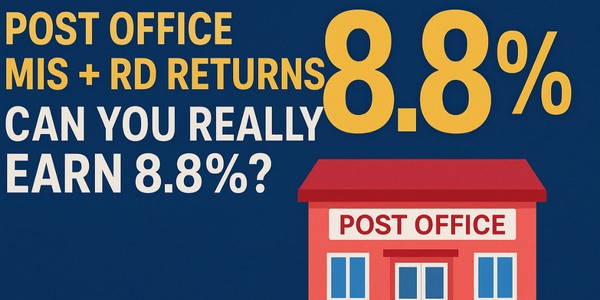Social media claims Post Office MIS + RD gives 8.8% returns. Is it true? Find the real post-tax XIRR and bust the myth of so-called experts.
Every few months, new videos and social media posts claim to have “discovered” a smart trick to earn higher returns from Post Office schemes. One such viral idea doing the rounds is —
“Invest in the Post Office Monthly Income Scheme (MIS) and reinvest the monthly interest in a Recurring Deposit (RD) — you’ll get 8.8% returns!”
A government-backed, risk-free 8.8% return sounds too good to ignore. But as I always say, in personal finance, if something sounds too good to be true, it usually is.
So, let’s break down this claim using the actual Post Office interest rates for Oct–Dec 2025, understand how MIS and RD work, and calculate the real return (XIRR) for different tax situations — including zero tax.

Understanding the Basics: What Are MIS and RD?
Before calculating returns, we need to understand how each of these schemes functions.
Post Office Monthly Income Scheme (MIS)
So, MIS is basically an income-generating scheme. It doesn’t reinvest the interest — you have to manually use or reinvest that monthly income.
Post Office Recurring Deposit (RD)
RD is ideal for those who want to build savings gradually. Now, in this “viral combo strategy,” the MIS monthly interest is being redirected into an RD every month.
The Viral Claim — “Earn 8.8% Return!”
Here’s the story many videos and posts tell:
At first glance, it looks perfectly logical. But when you dig deeper, you’ll realize it’s mathematically flawed. Let’s see why.
Why This Calculation is Wrong
Both MIS and RD interest are fully taxable under “Income from Other Sources.”
If you fall in a 20% or 30% tax slab, your effective return falls sharply.
Even if you are in the 0% tax bracket, remember that no Post Office scheme (other than PPF or Sukanya Samriddhi) gives tax-free interest.
This is the most common mistake in viral calculations.
Post Office RD compounds quarterly, not monthly.
That means every three months, the interest is added to the balance — not every month. Hence, the maturity amount will be lower than what these viral posts claim.
When you invest at different times (like every month into an RD), you cannot just add up total returns and divide by the number of years.
The correct way to find the true annualized return is by using the XIRR (Extended Internal Rate of Return) method, which accounts for the timing of every cash inflow and outflow.
Let’s Calculate the Real Return (Using Actual Rates)
Let’s assume you invest Rs.9,00,000 in MIS at 7.4%, and the monthly interest is invested in a 5-year RD at 6.7% (quarterly compounding).
We’ll calculate for four tax scenarios:
Common Assumptions
Case 1: Zero Tax Liability
You receive the full Rs.5,550/month from MIS and reinvest it in RD.
RD Maturity Calculation (6.7% compounded quarterly):
After 60 monthly deposits of Rs.5,550, your RD matures at approximately Rs.3.96 lakh.
At the end of 5 years, you also get back Rs.9,00,000 from MIS.
Total Maturity = Rs.9,00,000 + Rs.3,96,000 = Rs.12,96,000
When we calculate the XIRR, it works out to around 7.4% per annum.
So, for someone who pays zero tax, this combo roughly equals the MIS rate itself. There’s no “extra magic” happening here — the 8.8% claim is simply wrong.
Case 2: 5% Tax Slab
Tax reduces your monthly reinvestment to Rs.5,272 (Rs.5,550 – 5%).
Your RD matures at approximately Rs.3.76 lakh, and you get back Rs.9 lakh from MIS.
Total Maturity = Rs.12,76,000
XIRR = ~7.1% per annum
Case 3: 20% Tax Slab
After 20% tax, your reinvestment falls to Rs.4,440/month.
Your RD matures at approximately Rs.3.12 lakh, and MIS principal of Rs.9 lakh is returned.
Total Maturity = Rs.12,12,000
XIRR = ~6.2% per annum
Case 4: 30% Tax Slab
After 30% tax, you can reinvest only Rs.3,885/month.
Your RD matures at approximately Rs.2.72 lakh, plus Rs.9 lakh MIS principal.
Total Maturity = Rs.11,72,000
XIRR = ~5.2% per annum
Summary Table: Realistic Returns from MIS + RD Combo
| Tax Slab | Monthly RD Investment | RD Maturity (5 yrs @6.7%) | Total Maturity (MIS+RD) | Realistic XIRR |
| 0% | Rs.5,550 | Rs.3.96 lakh | Rs.12.96 lakh | 7.4% |
| 5% | Rs.5,272 | Rs.3.76 lakh | Rs.12.76 lakh | 7.1% |
| 20% | Rs.4,440 | Rs.3.12 lakh | Rs.12.12 lakh | 6.2% |
| 30% | Rs.3,885 | Rs.2.72 lakh | Rs.11.72 lakh | 5.2% |
The Truth: There Is No 8.8% Return Here
The 8.8% return figure being circulated online is completely wrong.
It ignores tax, assumes incorrect compounding, and uses an unrealistic calculation method.
Here’s what’s real:
Even for someone with zero tax liability, the combo doesn’t yield more than 7.4%, which is just the MIS rate itself.
Should You Still Consider This Strategy?
This combination can be useful only if you are looking for predictable income and capital safety — not for maximizing returns.
Suitable for:
Not suitable for:
If you fall in a higher tax bracket, you can explore:
Final Thoughts
Before jumping into any viral investment “hack,” always pause and verify a few things:
In this case, the so-called 8.8% return is nothing but a myth.
The real post-tax returns from the MIS + RD combo will range between 5.2% to 7.4%, depending on your tax situation.
So yes, this is a safe and steady combination, but not a high-return investment. Always focus on post-tax, real returns — because that’s what truly matters to your wealth.
Copyright © 2019-2024 Bytesdaily All rights reserved. About Us | Contact Us | Disclaimer | Terms Of Use | Privacy Policy